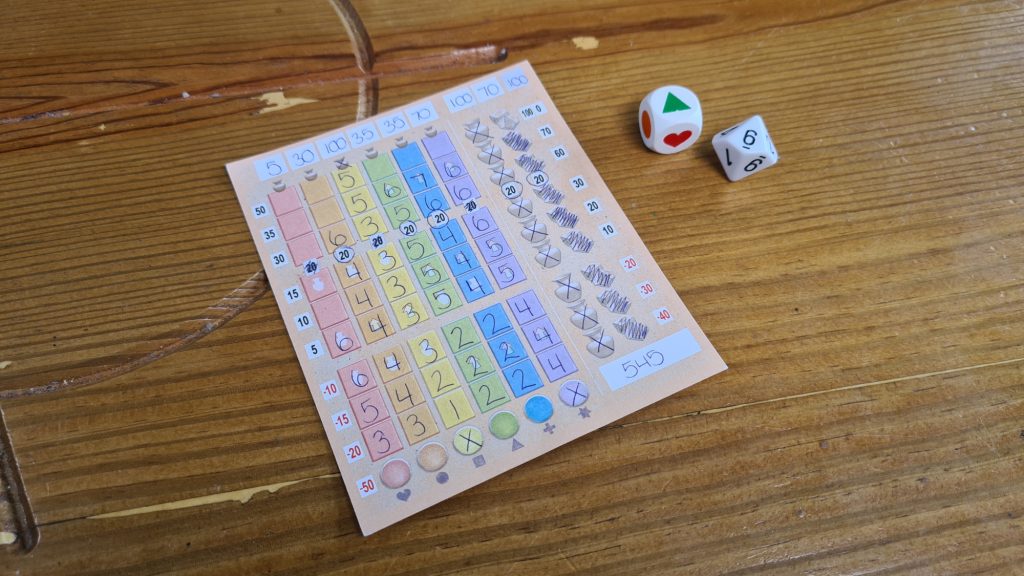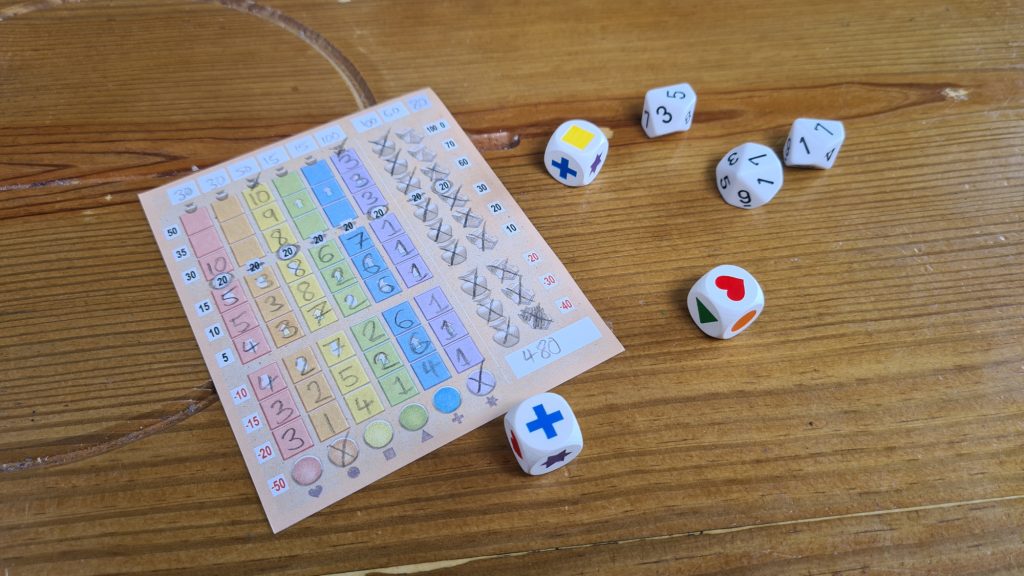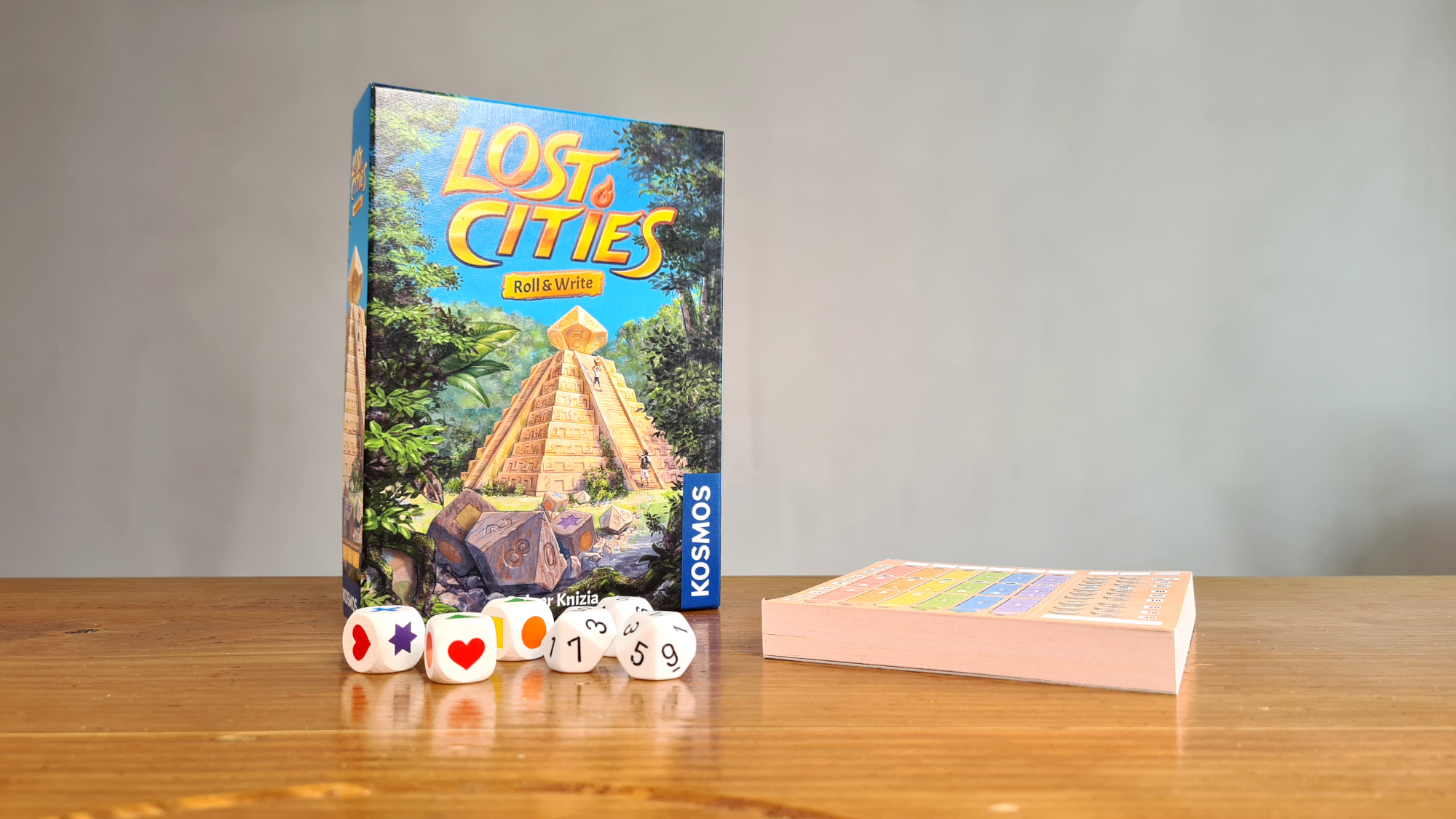Lost Cities Roll & Write is the brand new dice based board game from publisher Kosmos. Designed by Dr Reiner Knizia, the game sees 2 – 5 players going out on coloured expeditions, rolling dice and discovering artifacts along the way. Lasting around 20 minutes, the majority of the game is played simultaneously. However, is this an expedition to go on or should it remain lost? Let’s find out!
Each player starts the game with their own scoresheet. Featuring six coloured expedition columns, an artifact column and a dice column, this is how players will track their progress. The 3x colour dice and 3x 10 sided number dice are put into the middle of the table and the game is almost ready to play. Players just need to grab a pen or pencil and the expeditions can begin. The aim is effectively to choose the right dice combinations to get as high up as possible on expedition tracks, without getting exhausted.
Each turn the active player rolls the dice and chooses a colour die and a numbered die. This pair of dice is what the player can write onto their sheet. For example, if a red and a 4 are taken a 4 is to be written into the next free box in the red expedition column. A player can only take the dice if they are able to write the combination onto their sheet. Each expedition starts blank, with the first number of that colour written into the lowest box of the expedition. For all future combinations of that colour the value must be equal or higher to be written into the next free box.
Once the active player has chosen their pair, the other players can simultaneously make a colour number combination from the remaining 4 dice. These dice are not taken, with players free to use the same dice – just not the ones claimed by the active player. If a player cannot or chooses not to use a pair of dice they can instead cross off the next dice symbol on their scoresheet. If the active player does this they do not claim any dice, with the other players getting to choose from all 6 dice.

Adding the push your luck and risk aspect from the original game, in Lost Cities Roll & Write if a player takes a 0 value die with a colour they haven’t started an expedition of they mark the expedition as a lead expedition. This is effectively doubling down. At the end of the game players earn points for each expedition based on how far it got. The first 3 spaces of an expedition though lose the player points, which can also be doubled for an even bigger loss.
There are a few key features on the scoresheets. Featured on a number of the expedition spaces are vases. When collected this lets the player cross off the next artifact on their scoresheet. Some of the remaining spaces have arrow symbols. Writing a number into one of these spaces accelerates any expedition by one space. This sees the next free space of any expedition filled in with the same number it is currently on – this can even start an expedition using a value of 1.
By pushing their way up the expedition columns players will be earning more points but they will also be able to cross point scoring bridges. The first player to cross the bridge of any expedition, the artifact column or even the dice column circles the 20 bonus points. Unfortunately for everyone else they strike through the bonus, being unable to claim it later on. However, multiple players can trigger the bonus if they do it on the same turn.
The game continues, with the active player going clockwise around the table. When a player reaches the top of the dice column, from not using a dice pair 9 times, they become exhausted. Normally players gain points for not using dice but if they are exhausted they will score 0 for that column. Exhausted players continue as normal but the game will end when all players become exhausted. The game also ends if all of the bridges are crossed. At this point players count up their points, doubling the points gained or lost from lead expeditions. The winner is whomever has the most points, with joint winners possible.

Lost Cities Roll & Write is, like many games of the genre, numbers focused. On most turns you’ll be able to make a pair of dice to use and thanks to the points on offer even not taking dice can be worthwhile. Putting single numbers in each round could become less exciting across repeated plays and this is where the acceleration spaces and bridges show their worth. The bridges can be enough points to swing a victory and therefore can force players into suboptimal moves in order to trigger them first. Combine this with the acceleration spaces that allow players to take bigger than normal turns and the choices of what to take and when not to take something flourish.
Throughout the 20 – 30 minutes of gameplay there are occasional moments of downtime, when waiting for other players to make decisions. For the most part though, as long as the players don’t suffer too much from analysis paralysis, the game flows fast. As the inactive players also get to use the dice each turn, players are always involved – often praying that the active player doesn’t take that great number or colour they want to use.
One of the key features of the Lost Cities card game was the push you luck and risky factor behind doubling down on an expedition. That has translated across, with needing the right dice roll aligning with needing the right card and the fact this must be played prior to starting an expedition. The risk factor however never feels as strong. With the way inactive players have the choice to form a pair from 4 dice players need to get rather unlucky to actually score negative points. The choices are still there and the possibility of negative points still drives players to choose a pair of dice over another – it just doesn’t seem as risky to mark an expedition as a lead one whenever possible.
There aren’t many components in the box, though what is there is well designed. The colours each have a unique shape associated with them, featuring on the dice and the scoresheets. This instantly removes any concern of the game not being colourblind friendly. The sheets are pretty self explanatory and there is enough space for every number, cross and circle players will need to write, with everything being clear to read at a glance. Alas, while not every roll and write game comes with pens or pencils, it still feels a bit cheap to not include any in the box.
Lost Cities Roll & Write has captured much of the original game. The way players must choose to double down on expeditions before starting them provides the same choices but doesn’t always present the same risk factor of old. With points on offer for the expeditions, bridges, artifacts and not using the dice there are plenty of ways to gain points. This results in the game feeling like progress has always been made, with a sense of achievement if you manage to use the dice the best. For fans of the original, or those new to the series, Lost Cities Roll & Write could be the new filler game you’re looking for.
(Editor’s Note: Lost Cities Roll & Write was provided to us by Kosmos for the review. Check out the official game page here.)

